We’ve created the ultimate guide to what to wear on safari. Plus, we’re sharing a complete packing list that has all the essentials, as well as what NOT to pack for your African safari.

After five safari trips, I know a thing or two about what to pack and how to dress for an African safari.
In this article, I’ll break down exactly what to wear on safari as well as walk you through my suggestions for what to pack so you don’t forget any of the essentials. Plus, I’m sharing some insider tips that can save you big money as you prepare for your African adventure of a lifetime.
The best part is, if you follow this guide you should be able to fit everything into a carryon, which will make your life so much easier. (Trust me when I say you don’t want to lug around a giant suitcase between safari lodges in the African bush!)
Get ready to start packing!
Safari Packing Guide
For more tips and advice for planning your safari packing list, jump to the following sections (or just keep scrolling to see it all!).
- General packing guidelines
- What to wear on safari
- What NOT to wear on safari
- Travel essentials for your African safari
- Packing tips for an African safari
- Ultimate safari packing list
General guidelines for what to wear on safari
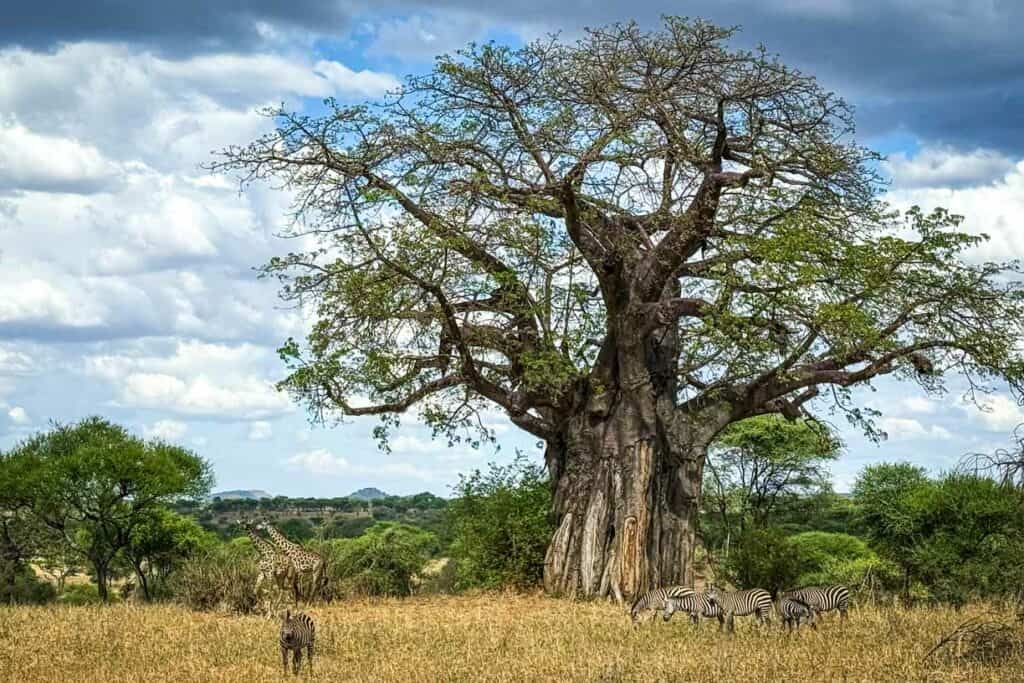
There is a common misconception that going on safari has a strict dress code: you need to dress head-to-toe in khaki, complete with hiking boots, a wide-brimmed hat and binoculars.
Be honest, you’re picturing that exact look right now aren’t you?
Well I’m here to tell you, that is not actually the case. There is no strict dress code for safari. And for the most part, you can wear whatever you please.
However, there are some general guidelines and things to consider when planning what to wear on safari.
1. Dress comfortably

This is my number one guideline because I think it’s the most important factor in planning your safari outfits.
When going on safari in Africa, you’ll be spending a lot of time sitting in your safari vehicle (whether self-driving or on a guided game drive). Like, a lot. In my experience, guided game drives can either last all day, or happen twice a day, at sunrise and sunset for 3-4 hours at a time.
So be sure to pack and wear clothes you are comfortable sitting in!
2. Neutrals and earth tones are best, but not 100% necessary
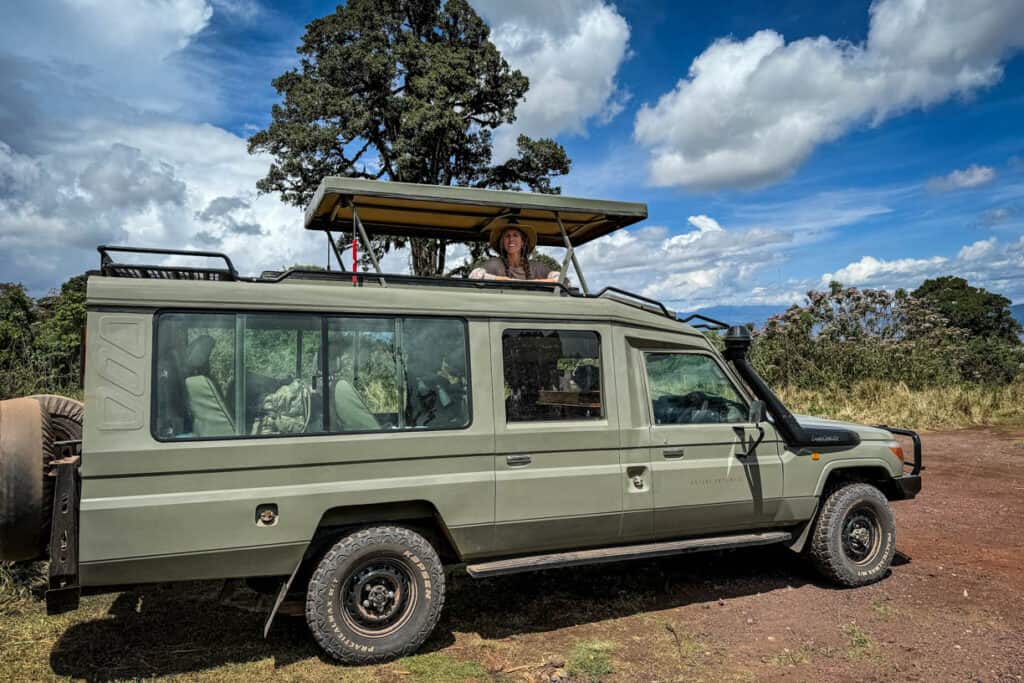
It’s true, wearing neutral colors and earth tones (like beige, khaki, brown and olive green) is a good idea on safari. You’ll blend in more with the vehicle and landscape without drawing attention to yourself.
The general idea on safari is that you want to be the one spotting the animals, not the other way around.
This is especially important if you are going on a walking safari.
However, when sitting in a vehicle, much of your clothing won’t be exposed to the outside anyways. So, if you just have muted colors or black and white* instead of head-to-toe khaki, you’ll be just fine.
*A note on wearing black and white: In some places, the color black (and dark blue) can attract certain pests such as Tsetse Flies. I’ve never experienced this myself, but I’ve heard they have nasty bites and are not fun to deal with. So if you choose to wear black, make sure you’re covered and have bug spray. On the other hand, wearing white isn’t a problem for the pests, but it gets very dusty and dirty in the African bush, so you may want to avoid white colors as well.
3. Avoid wearing bright colors
To piggy-back on the above, avoid wearing bright colors on your safari. While you don’t need to go out of your way to purchase an entire wardrobe in earth tones, you should avoid packing anything in bright colors as these colors attract and catch the animals’ eyes.
Stick to muted tones and neutral colors for your safari wardrobe as best you can.
4. Dress in layers

Depending on where you are going on safari and what time of year, the weather may vary drastically. Even during summertime in some African countries, the bush gets cooler at night.
In my experience, it was always cooler before sunrise and after sunset – especially when you’re flying through the bush in an open-air safari vehicle, wind whipping at your face.
Check the weather before you make your safari packing list and be sure to pack layers you can remove as the day warms up. I always bring a light jacket for early mornings and evenings on safari.
It’s always a good idea to wear long pants and long sleeves on safari as these will keep the bugs off you as well as protect you from the harsh African sun. Plus, in some African countries, it’s best to dress modestly – opt for t-shirts over tank tops.
5. Choose light, breathable fabrics and sun protection

On the same token as above, it can get scorching hot in the midday sun in the African bush. Make sure you wear light, breathable clothing so you’re not sitting in a pool of sweat for hours at a time.
Workout/activewear makes good safari clothing as it is generally light and breathable, wicks sweat, and is comfortable enough to sit in for long game drives. Linen is another good fabric in neutral colors for safari.
If you are going on guided game drives, safari vehicles vary widely, but usually you will be exposed to the elements. (For example: some safari vehicles have covers and some are completely open-topped.)
No matter what time of year, be prepared with sun protection! Even if it’s cloudy, it’s a good idea to wear sunscreen and a wide-brimmed sun hat is also a good idea.
→ Psst! We’re settling the age old debate: whether to travel with a backpack or suitcase? In our article, we break down the pros and cons of each to help you decide!
What to wear on safari for men and women

Now that you have an idea of the general guidelines, I’m going over exactly what to wear on safari for both men and women to give you a solid idea of what to pack.
Women’s clothing
- Comfortable bottoms for game drives
- I tend to wear jeans or leggings on safari (I recently purchased these olive green leggings and love them!)
- These hiking pants also make good safari wear
- Sports bras
- Trust me, you’ll thank me for this suggestion after driving for hours down a bumpy dirt road through the African bush
- T-shirts or tanks
- Keep in mind you should dress more conservatively in some African countries (South Africa is pretty much anything goes, but in Tanzania I personally felt a bit too exposed in a tank top and opted for t-shirts instead).
- Long sleeve tops
- Pack a few long sleeve tops you can wear over your tanks/t-shirts
- This shade hoodie is a good option for SPF protection
- I also packed this lightweight long sleeve (in color: pumice) on my last safari and loved it!
- This button down nails the classic safari look
- Loungewear for around the lodge
- Pack shorts and comfy clothes to wear around the lodge when you’re not on a game drive
- Nicer outfits for dinner
- This is more of a personal preference than totally necessary, but I prefer to not look grungy at dinner
- Swimwear
- Often safari lodges have pools you can relax in during the midday heat when all the animals are hiding from the sun
- Socks, underwear, and pajamas
Men’s clothing
- Comfortable bottoms for game drives
- Jeans or these hiking pants would work well
- Ben is obsessed with these pants that are super comfy (and versatile!) , they would work well on game drives but also look really nice and can be dressed up.
- T-shirts
- Remember to stick to neutral colors and earth tones as much as possible
- Long sleeve tops
- This lightweight button down gives you the classic safari look
- Here is the same shade hoodie for men
- I also packed this lightweight long sleeve (in color: pumice) on my last safari and loved it!
- If you want to go super safari nerd, this button down nails the classic safari look
- Loungewear for around the lodge
- Think shorts and t-shirts as it’s likely to be warmer during midday
- Nicer outfits for dinner
- Again, a personal preference, but you could pack a nicer pair of pants and a couple collared shirts for dinners at the lodge
- Swimwear
- Socks, underwear, and pajamas
Outerwear
- Rain jacket: It’s always a good idea to pack one for safaris in case it rains, many companies also provide ponchos for heavier rains
- Light jacket for early mornings and evenings
- I bring my lightweight down jacket everywhere with me, and it’s definitely come in handy on safari in the summertime (January) in South Africa
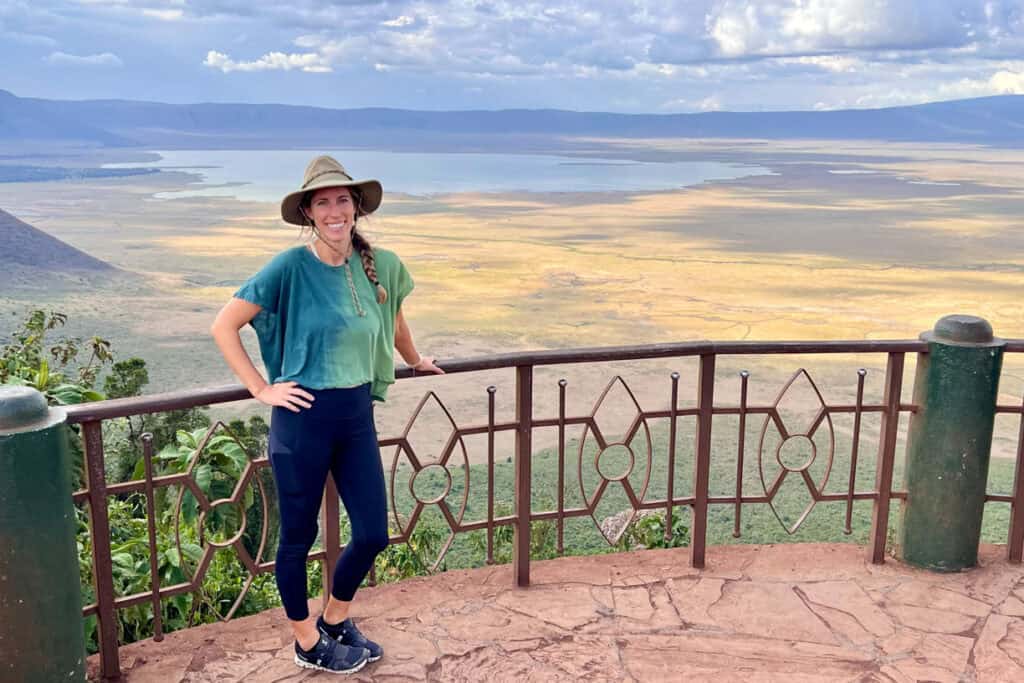
Accessories
- Sun hat: It’s good to have a wide brimmed hat for sun protection on safari
- Sunglasses
Footwear
- Closed-toe shoes for game drives
- I tend to wear regular athletic sneakers, it doesn’t really matter as long as your comfortable
- You may get out of the vehicle on occasion for sundowners or bathroom stops so it’s good to have closed-toe shoes
- Boots (optional)
- If you plan on doing a walking safari, it’s a good idea to wear hiking boots
- Comfy slip-on sandals for around the lodge
- I live in my rubber Birkenstocks pretty much anywhere I go, but they are especially great for lounging by the pool and double as shower shoes if I need them
What NOT to wear on safari
There are a few things you want to keep in mind NOT to bring when you are thinking about what to wear on safari.
- Perfume/cologne: Avoid wearing any strong scents as this can repel or attract unwanted attention from animals
- Nice jewelry: Remember you’re in the African bush, not on the streets of Paris, leave your valuable jewelry at home for this trip
- Bright colors: We already covered this in our general guidelines above, but just a reminder to avoid wearing bright colors that’ll catch the attention of animals (you want to blend in and not stand out)
- Fancy clothes/dresses: Again, you are in the African bush, sitting for hours at a time under the sun in a safari vehicle. You will not want to be wearing fancy or tight dresses, short skirts, or high heels.
Travel essentials your African safari

- Quality luggage (we love our Away suitcases!)
- Packing cubes
- Dirty laundry bag
- Trust me, some of your safari clothes will get dirty and you’ll want to separate them from your clean clothes
- Day pack for bringing along on game drives
- I love my Herschel packable backpack
- Refillable water bottle to bring on long game drives
- Binoculars (optional)
- These are optional, but highly recommended as oftentimes your guide will spot animals way off in the distance and if you don’t have binoculars, you’ll miss out!
- eSIM
- If you’ve never done this before, our guide to getting an eSIM will be super helpful!
- Travel insurance
- We have an entire guide that goes over how to choose the best policy for you in detail.
Camera gear
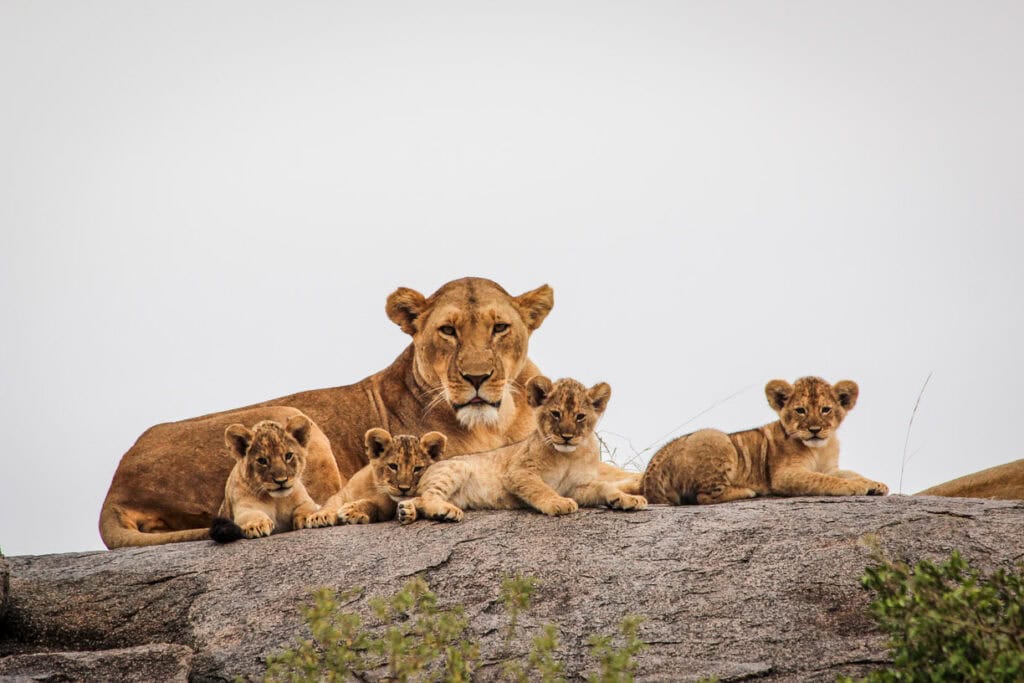
You are going on safari after all! I recommend you invest in a decent camera with a zoom lens.
- If we had to choose one camera for safari, it would be the Nikon D3400 or the Canon EOS REBEL T7 with a 75-300 mm zoom lens.
- Make sure to bring your charger and extra batteries!! I speak from experience when I say the WORST thing ever is when the lion pops out right in front of your vehicle and your camera battery dies.
- And you’ll want to make sure you have plenty of space on your memory card(s)! (This goes for your phone as well – if you are relying only on that for photos – make sure you have the storage space capabilities!)
Psst! Check out our tips for taking better travel photos, and be sure to scroll to the section about which camera is best for you!
Electronics
Only bring what you really need. Safari lodges often have spotty wifi, so leave your laptop at home and unplug for a bit!
- Universal adapter: Check what plugs are used in the country you’re traveling to before you go and if a universal adapter will work.
- South Africa has country-specific outlets that are unlike any on my universal adapter, so I had to buy a South-Africa specific adapter. However, Tanzania uses the same plugs as the UK so my universal adapter works there.
- Power bank: This is also good for charging your phone on the go during game drives
- Kindle: This is nice for killing time at the lodge
- Headlamp: This will come in handy at your lodge after dark
Toiletries
- We pack our toiletries in a bag like this one to make sure everything stays organized.
- We have a more detailed list of specific toiletries you’ll need in our safari packing list, including a few items that are safari-specific that you won’t want to forget!
Medications
- Check with the CDC to see what travel vaccinations are recommended for your safari destination(s) in Africa. You will need to arrange these before your trip.
- If you are prescribed malaria meds, don’t forget to start taking them 2 days before your trip and bring them along for the duration.
- Any daily meds you need
- Antihistamines (if you are prone to environmental allergies)
- Non-drowsy Dramamine: in case you get car sick in the safari vehicle (I swear by this stuff!)
- Anti-diarrhea meds – always a good idea to have some on hand in a new place
- Natural jet lag remedy: We’ve been using these on our recent trips and find them helpful!
Packing tips for your African safari
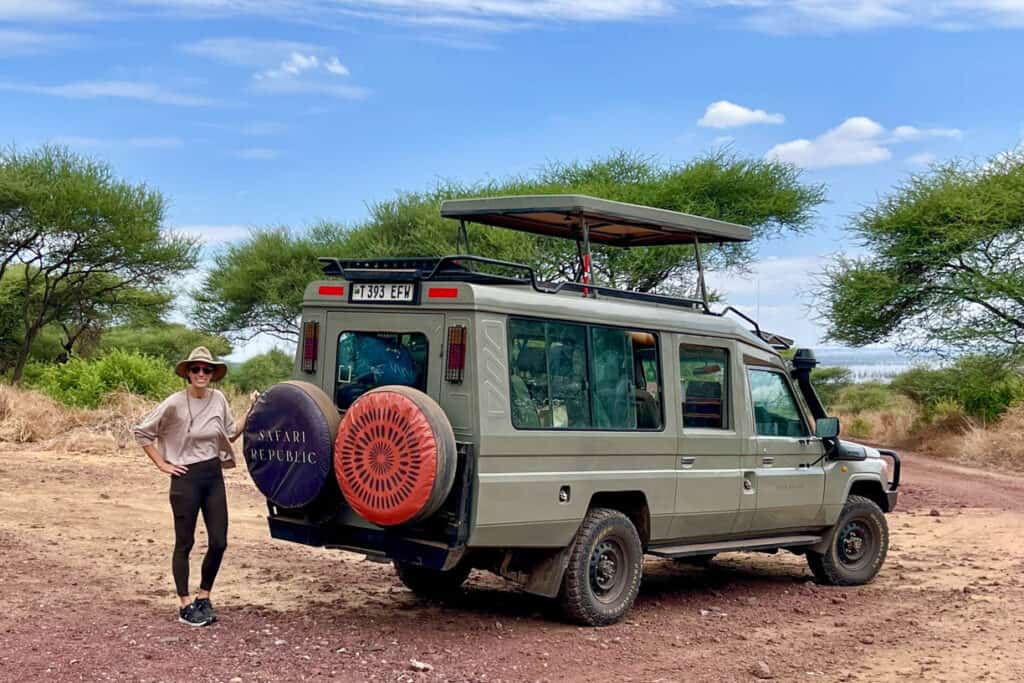
- Everything will get dusty. While on game drives, you’ll be riding down primarily dirt roads in open-air vehicles and you will get dusty! Be prepared for this by packing enough clothes for your safari and a laundry bag to separate your dirty clothes from the clean ones.
- Dress appropriately in conservative countries. While pretty much anything goes in South Africa, other African countries tend to be a bit more conservative.
- I personally felt uncomfortable in Tanzania wearing just a tank top and leggings as I didn’t see any other tourists in the picnic areas showing as much skin (despite the heat!). So I wound up having to rewear the few t-shirts I had packed day after day.
- Know your luggage restrictions. If you are taking a bush plane between safari lodges, know they have very strict (and limited) luggage restrictions. Make sure you know how much luggage you are allowed before you show up with a giant 50 pound hard-side suitcase.
- Even the safari vehicles have limited space for luggage and will strap your suitcase to the top (think very dusty!) if it’s too large to fit in the back.
- Bring cash for tipping. Remember to tip your safari guide and even in some cases your lodge cleaning staff. For this you will need cash. Most places prefer USD or Euro over their home currency, however, in a pinch you can always withdraw cash from a local ATM when you land at the airport.
- A general rule of thumb is to tip your safari guide $20-$25 USD per day
- Safari lodges also have tip boxes where you can leave a tip to be distributed to the entire staff. We were told $20 USD per night was acceptable.
Safari packing list
We’ve organized everything you’ll need to pack for your safari into a handy, FREE checklist. Just click below to enter your email and get a PDF of our ultimate safari packing list sent right to your inbox!

You may also like…
- Best Place to Go on Safari in Africa (unique destinations + expert tips!)
- Best Time to Visit South Africa: When to Go & When to Avoid!
- Ultimate Tanzania Safari Itinerary (5+ days!)
- How Much Does a Tanzania Safari Cost? (+ tips to save!)
Save this article on Pinterest for later!


We want to hear from you!
Do you still have questions about what to wear on safari after reading this article? Are you planning an African safari and have more questions? Leave us a comment below and we’ll do our best to get back to you!
